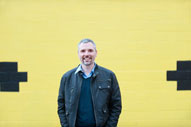
Metro Detroit recently landed a $2.85 million Sustainable Communities grant to help the region become more dense and develop its transit options. Brad Garmon, land programs director at the Michigan Environmental Council, offers a free-thinking approach to connecting the historically disparate forces of housing, land use, and eco-consciousness.
Post 4: The New Sustainability
Posted By: Brad Garmon
Posted: 12/6/2010
The environmental community I'm proud to be a part of has been focused, at least since Thoreau and John Muir and David Brower, on the notion that fostering individual, intimate connection to the natural world helps us secure a viable ecosystem.
What followed, naturally, was a movement both passionate and noble in its dedication to preserving awesome big places, subtle connections of microscopic creatures, and to human access to the richness and diversity of earth in all its crazy, pungent, unregulated amazingness.
That's incredibly important work. Some of my favorite people are the foresters and the ecologists and the hydrogeologists who work to understand and preserve the mechanisms underlying the world we depend on.
But environmentalism has changed dramatically in recent years, embracing another related scope of work with big implications for the natural world.
Rather than connecting us to nature, this side of environmentalism focuses on connecting us to each other and our communities.
The Sustainable Communities grant program I've been writing about this week brings this shift to the forefront in a big way, focusing on uniting three historically disconnected aspects of community development: transportation, housing and natural resource protection.
Just think for a minute about how those three features intertwine in your own neighborhood, town or region.
Is housing for the elderly close to destinations? Can kids ride their bikes around the neighborhood? How about to school? How would you access eggs or bread or fresh veggies without a car?
In truly thriving regions and communities, there are lots of options for all the above.
There are built-in connections and linkages that provide resiliency and offer multiple ways to get around and connect to the people and places that comprise a fruitful, productive life.
And that, in a nutshell, is the new sustainability. It's environmental sustainability redefined as place-making, as nurturing community interconnections, accessibility and relationships.
As a side benefit in these types of communities you also more often bump into people who surprise, challenge and inspire you – some people you know, many you don't, and many of whom don't think, look or behave like you. That kind of spontaneous interaction is good for the economy and builds resiliency in our communities.
My good friend, Conan Smith, lives in the Old West Side neighborhood within an easy walk of downtown Ann Arbor. He's survived for two years without a car, and he's also woven into the fabric of his community.
It's impossible to walk down the street with him if you're in a hurry, because he's bound to run into at least five people who want to chat – about work, about life, about the community.
His days, I would contend, are made richer and more productive and less fossil-fuel dependent simply because he lives in a place where – due to human-scale community design and higher residential density – spontaneous interaction is the norm rather than the exception.
The federal Partnership for Sustainable Communities defines sustainability by focusing on Six Livability Principles. They are the heart and soul of the program, and therefore central to the regional planning initiative the SEMCOG will be undertaking in Metro Detroit.
These sustainability principles are about more than environmental improvement. Places that embrace them are also more economically resilient.
Shelley Poticha, who directs the Office of Sustainable Housing and Communities at HUD in Washington, D.C., put it like this in an interview with Builder Magazine earlier this year: "When you look at the regions that are really embracing walkability, investing in transit, and thinking about natural resources protection, these are the regions that are weathering the downturn best."
"Denver is a good example," she says. "Yes, they took a hit, but most of the housing foreclosures are out at the periphery in "drive to qualify" neighborhoods. The city center and suburban centers around the region that have focused on place-making are still doing well – places like LoDo, the Denver Tech Center, Boulder, Broomfield, and similar towns."
In other words, the places that work well in sustainability terms – less driving is required to handle daily tasks – are also places that facilitate business connections, promote economic interactions and stabilize property values.
There are places in Metro Detroit where all of this happens right now. But we need more of them. Lots more.
And the new regional Sustainable Communities grant can help us identify and prioritize these places and projects, and build the partnerships that make them happen.